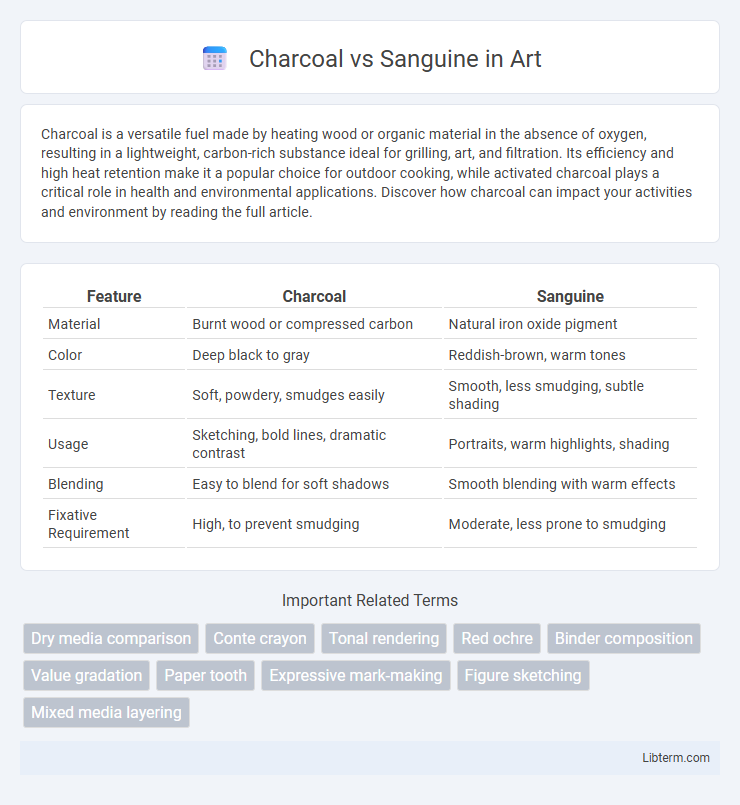Charcoal is a versatile fuel made by heating wood or organic material in the absence of oxygen, resulting in a lightweight, carbon-rich substance ideal for grilling, art, and filtration. Its efficiency and high heat retention make it a popular choice for outdoor cooking, while activated charcoal plays a critical role in health and environmental applications. Discover how charcoal can impact your activities and environment by reading the full article.
Table of Comparison
| Feature | Charcoal | Sanguine |
|---|---|---|
| Material | Burnt wood or compressed carbon | Natural iron oxide pigment |
| Color | Deep black to gray | Reddish-brown, warm tones |
| Texture | Soft, powdery, smudges easily | Smooth, less smudging, subtle shading |
| Usage | Sketching, bold lines, dramatic contrast | Portraits, warm highlights, shading |
| Blending | Easy to blend for soft shadows | Smooth blending with warm effects |
| Fixative Requirement | High, to prevent smudging | Moderate, less prone to smudging |
Introduction to Charcoal and Sanguine
Charcoal is a popular drawing medium made from charred wood, prized for its deep blacks and ease of blending to create rich, expressive sketches. Sanguine, a reddish-brown pastel or chalk, offers warm tones often used to depict flesh and natural textures in figure drawing and classical art. Artists choose charcoal for bold, dramatic contrasts and sanguine for softer, earthy hues that enhance lifelike warmth.
Historical Background of Charcoal and Sanguine
Charcoal drawing, dating back to prehistoric times, was widely used by Renaissance artists such as Leonardo da Vinci for its versatility and deep blacks. Sanguine, a reddish-brown chalk derived from iron oxide, gained popularity during the Renaissance for its warm tones and ability to mimic flesh tones in figure drawing. Both mediums have rich historical backgrounds rooted in classical art education and continue to be valued for their unique textures and expressive qualities.
Key Characteristics of Charcoal
Charcoal is a versatile drawing medium known for its rich, deep blacks and smooth texture, allowing for intense shading and expressive lines. It blends easily on various surfaces, from paper to canvas, making it ideal for creating dramatic contrasts and soft gradients. Its fragility and tendency to smudge require careful handling and fixatives to preserve finished artwork.
Defining Features of Sanguine
Sanguine is defined by its warm reddish-brown tones that create rich, earthy sketches imbued with a natural warmth and depth, unlike charcoal which primarily offers deep blacks and grays. Its medium composition, often made from iron oxide pigments, provides smooth blending capabilities and subtle shading variations that enhance the dimensionality of portraits and figure drawings. This distinctive color quality and texture make sanguine ideal for capturing lifelike warmth and organic softness in artwork.
Techniques for Drawing with Charcoal
Charcoal drawing techniques involve blending, layering, and using varying pressure to achieve rich, deep blacks and subtle grays, essential for creating texture and depth. Artists often employ kneaded erasers to lift charcoal, producing highlights and refining details with precision. Mastery of smudging tools, such as blending stumps, helps control tonal transitions and enhances the expressive quality unique to charcoal artwork.
Techniques for Using Sanguine
Sanguine drawing techniques involve using soft, reddish-brown chalk or pencils that allow smooth blending and shading to create warm, lifelike tones. Artists often employ hatching, cross-hatching, and smudging with stumps or fingers to build depth and texture while maintaining control over highlights and midtones. Unlike charcoal, sanguine's unique pigment composition enables subtle tonal variation without the intense contrast and dustiness associated with charcoal media.
Comparative Analysis: Charcoal vs Sanguine
Charcoal offers deep, rich blacks perfect for dramatic shading and strong contrast, while sanguine provides warm reddish-brown tones ideal for naturalistic and flesh studies. Charcoal's malleability allows for quick blending and smudging, whereas sanguine's harder texture facilitates finer detail and controlled strokes. Artists often choose charcoal for bolder, expressive sketches and sanguine for softer, more subtle line work and tonal gradations.
Best Subjects and Styles for Charcoal and Sanguine
Charcoal excels in creating bold, high-contrast drawings ideal for dramatic portraits, figure studies, and expressive landscapes, capturing deep shadows and textures with ease. Sanguine is perfect for warm-toned sketches such as classical figure drawing, anatomical studies, and Renaissance-style portraits, emphasizing soft shading and subtle details. Both mediums complement each other by offering versatility in tonal range and style, with charcoal emphasizing intensity and sanguine highlighting warmth.
Preservation and Care of Charcoal and Sanguine Artwork
Charcoal and sanguine artworks require careful preservation to prevent smudging and fading, as both mediums are highly susceptible to damage from moisture, dust, and light exposure. Fixatives should be applied sparingly to charcoal pieces to maintain the integrity of the drawing without altering texture, while sanguine works benefit from UV-protective glass framing to preserve their rich red-brown hues. Proper storage in acid-free materials and a stable environment with controlled humidity and temperature significantly extend the lifespan of both charcoal and sanguine artworks.
Choosing Between Charcoal and Sanguine: Artist’s Perspective
Choosing between charcoal and sanguine depends on the artist's intent and desired effects; charcoal offers deep blacks, rich contrast, and versatility for expressive shading, while sanguine provides warm reddish-brown tones ideal for capturing flesh and natural warmth. Artists favor charcoal for dramatic, bold sketches and sanguine for soft, classical portraits rooted in Renaissance traditions. Understanding material properties and desired emotional impact guides the selection between these two mediums.
Charcoal Infographic

 libterm.com
libterm.com